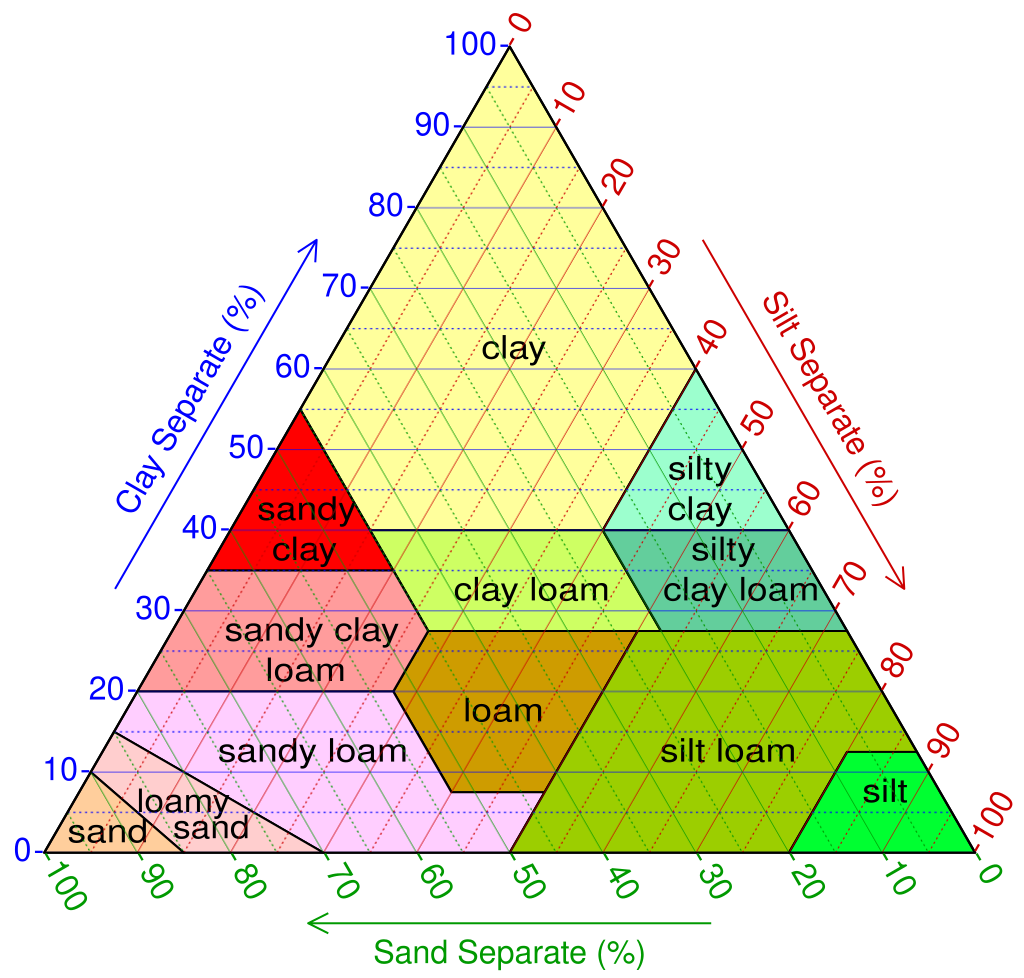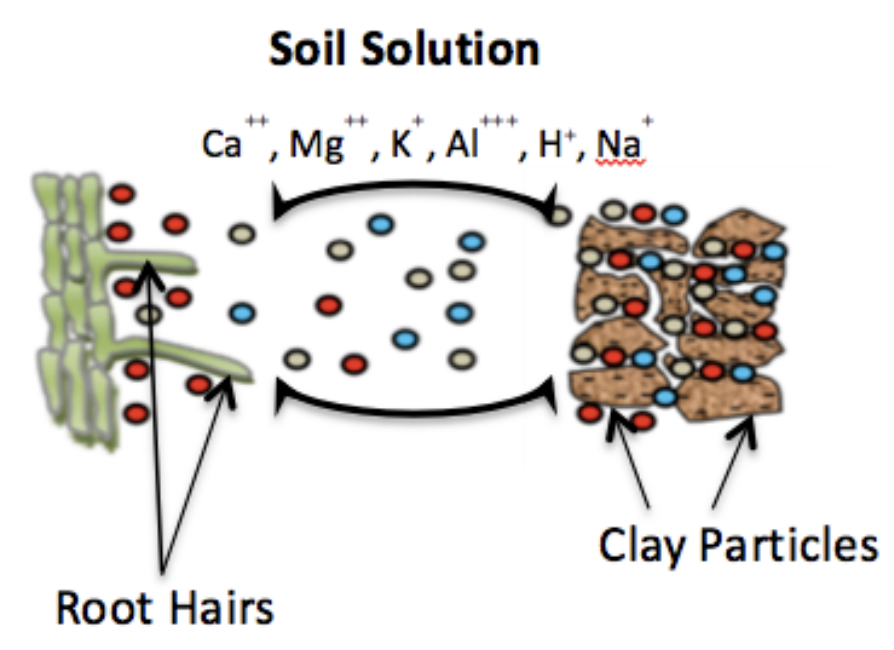IB Syllabus focus:
‘Texture reflects sand, silt, clay and humus proportions. Humus boosts structure, nutrient and water retention; clays have higher cation-exchange capacity than sands/silts.’
Soil fertility depends strongly on texture, humus content, and the balance between sand, silt, and clay. These factors shape soil’s capacity to support healthy ecosystems.
Soil Texture
The Role of Particle Size
Soil texture describes the relative proportions of sand, silt, and clay particles. Each particle type contributes different properties to the soil system.
Sand (largest particles): provides drainage and aeration, but low nutrient retention.
Silt (medium particles): holds water moderately well, improves soil cohesion.
Clay (smallest particles): retains nutrients and water effectively but can restrict drainage and root penetration.
Soil Texture: The relative proportions of sand, silt, and clay in a soil sample, usually expressed as a percentage of each.
A soil’s texture determines porosity, permeability, and overall fertility. For example, sandy soils drain quickly, while clay soils can become waterlogged.

USDA soil texture triangle showing classification by percentage of sand, silt and clay. Read across the three axes to locate the texture class (e.g., loam near the centre). This diagram underpins how texture influences water and nutrient behaviour discussed in the notes. Source.
Soil Texture Triangle
In environmental science, soils are classified using a soil texture triangle, which maps out percentages of sand, silt, and clay to determine the soil type (e.g., loam, sandy clay loam).
Loam is considered the most fertile balance, combining aeration, water-holding capacity, and nutrient availability.
Humus and Its Functions
Formation of Humus
Humus forms when organic material such as leaves, roots, and dead organisms decompose and become stable organic matter within the soil. It is dark in colour and rich in carbon.
Humus: The stable, organic component of soil formed through decomposition of plant and animal matter.
Humus contributes to soil fertility in several ways:
Enhances soil structure by binding mineral particles into aggregates.
Increases water retention, allowing soils to remain moist for plant use.
Provides a slow release of essential nutrients, especially nitrogen and phosphorus.
Promotes microbial activity, which accelerates nutrient cycling.
Humus and Soil Structure
Humus improves soil’s ability to form crumb structure, meaning soil particles stick together in porous aggregates. This prevents compaction and improves root penetration.
Fertility and Soil Properties
Cation Exchange Capacity (CEC)
Soil fertility depends on the ability of soil particles to hold and exchange nutrients. This is known as cation exchange capacity (CEC).
Cation Exchange Capacity (CEC): A measure of how well soil can retain positively charged ions (cations) such as calcium (Ca²⁺), potassium (K⁺), and magnesium (Mg²⁺).
Clays have a high CEC, enabling them to store nutrients effectively.
Sands have a low CEC, making them poor at nutrient retention.
Humus also has a very high CEC, greatly enhancing soil fertility.

Schematic showing nutrient cations (e.g., Ca²⁺, Mg²⁺, K⁺) adsorbed to negatively charged clay/organic surfaces and replenishing the soil solution at root hairs. This illustrates why clay- and humus-rich soils have higher CEC and reduced leaching compared with sandy soils. The figure also includes root hairs for contextual clarity beyond the minimum syllabus detail. Source.
Nutrient Retention
Nutrients critical for plant growth, such as nitrogen (N), phosphorus (P), and potassium (K), are stored within soils through CEC.
In clay-rich or humus-rich soils, these nutrients are less likely to leach away.
In sandy soils, nutrients are more easily lost with rainfall or irrigation.
Linking Texture, Humus, and Fertility
Balancing Components
The interaction of texture and humus content explains why some soils are more productive:
Sandy soils: well-drained but need humus to retain nutrients.
Clay soils: nutrient-rich but risk waterlogging without organic matter to improve structure.
Loam soils: balanced mixture of sand, silt, clay, and humus, ideal for most crops.
Processes Affecting Fertility
Soil fertility is not static — it changes through natural and human processes:
Decomposition of organic matter adds humus and nutrients.
Erosion can strip away fertile topsoil, reducing organic matter.
Leaching removes soluble nutrients, especially in sandy soils.
Salinisation reduces fertility by leaving salt residues in soil pores.
The Importance for Plant Growth
Water Retention and Availability
Plant productivity depends on soil’s capacity to supply water at rates suitable for root absorption.
Sandy soils dry quickly and need frequent replenishment.
Clay soils retain water but may restrict oxygen supply to roots.
Humus moderates these extremes, ensuring a steady water supply.
Root Penetration
Roots grow more easily in soils with good structure. Excessive clay can compact, creating barriers, whereas humus improves aeration and reduces compaction.
Summary of Key Points
Soil texture is determined by sand, silt, and clay proportions.
Humus improves soil structure, water retention, and nutrient supply.
Clays have higher CEC than sands or silts, meaning they retain more nutrients.
Fertile soils usually contain a balanced mix of texture and organic matter, forming loams.
Soil fertility is dynamic and can be enhanced or degraded through natural cycles and human practices.
FAQ
Soils with high sand content are more prone to erosion because larger particles are less cohesive and easily detached by wind or water.
Clay soils, though resistant to detachment, may suffer erosion if compacted and lacking organic matter. Loam soils, with balanced proportions and humus, have greater aggregate stability, making them less vulnerable to erosion.
Humus contains decomposed organic compounds such as lignin and complex carbon molecules, which are naturally dark.
This darker colour helps soils absorb more heat, which can improve microbial activity and extend growing seasons in cooler climates.
Soils with low cation exchange capacity, such as sandy soils, lose applied fertilisers quickly through leaching. This requires more frequent applications to maintain productivity.
By contrast, soils rich in clay or humus hold nutrients more effectively, meaning fertilisers can be applied less often and in smaller amounts, reducing both cost and environmental impact.
Sandy soils, with high porosity and permeability, allow water to infiltrate rapidly, enhancing groundwater recharge but reducing surface water availability.
Clay soils slow infiltration due to small particle size, limiting recharge but increasing surface water retention. Loams balance both processes effectively.
Farmers can increase humus content by:
Adding composts, manures, or crop residues.
Using cover crops and green manures to supply organic matter.
Minimising tillage to reduce decomposition rates.
These practices not only sustain humus but also improve soil structure, water retention, and nutrient supply over time.
Practice Questions
Question 1 (2 marks)
State two ways in which humus contributes to soil fertility.
Mark scheme:
Enhances soil structure by binding mineral particles into aggregates (1 mark).
Increases water retention within the soil (1 mark).
Provides slow release of nutrients such as nitrogen and phosphorus (1 mark, maximum 2 marks overall).
Question 2 (5 marks)
Explain how soil texture influences water retention and nutrient availability, and evaluate the role of humus in modifying these properties.
Mark scheme:
Sandy soils drain quickly and have low nutrient retention due to large particle size and low cation exchange capacity (1 mark).
Clay soils retain water and nutrients well but may restrict drainage and root penetration (1 mark).
Silt holds moderate amounts of water and improves soil cohesion (1 mark).
Humus improves fertility by increasing cation exchange capacity and nutrient retention (1 mark).
Humus also enhances structure, balancing extremes in sandy or clay soils, thus improving plant productivity (1 mark).
(Any 5 points, maximum 5 marks.)

